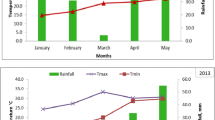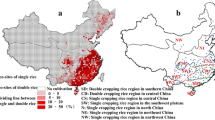Abstract
Crop models are suitable tools to assess the potential impacts of climate change on crop productivity. While the associated assessment reports have been focused on major rice production regions, there is little information on how climate change will impact the future rice crop production in mountainous highland regions. This study investigated effects of climate change on yield of paddy rice (Oryza sativa) in mountainous highland terrains of Korea using the CERES-Rice 4.0 crop model. The model was first calibrated and validated based on observed data and then applied to simulations for the future projections of rice yield in a typical mountainous terrain which borders North and South Korea, the Haean Basin in Kangwon Province, Republic of Korea. Rice yield in the highland terrain was projected to increase by 2050 and 2100 primarily due to elevated CO2 concentration. This effect of CO2 fertilization on yield (+10.9% in 2050 and +20.0% in 2100) was also responsible for increases in water-use efficiency and nitrogen-use efficiency. With management options, such as planting date shift and increasing nitrogen application, additional yield gains were predicted in response to the future climate in this area. We also found that improving genetic traits should be another option to get further yield increases. All in all, climate change in mountainous highland areas should positively influence on paddy rice productivity.
Similar content being viewed by others
References
Adams RM, Rosenzweig C, Peart RM, Ritchie JT, McCarl BA, Glyer JD, Curry RB, Jones JW, Boote KJ, Allen LH. 1990. Global climate change and US agriculture. Nature 345:219–224
Ahuja LR, Rojas KW, Hanson JD, Shafer MJ, Ma L. 2000. Root zone water quality model-Modeling management effects on water quality and crop production. Water resources publications, LLC CO, USA, pp 372
Ainsworth E. 2008. Rice production in a changing climate: a meta-analysis of responses to elevated carbon dioxide and elevated ozone concentration. Global Change Biol. 14:1642–1650
Allen LH, Boote KJ, Jones JW, Valle RR, Acock B, Rogers HH, Dahlman RC. 1987. Response of vegetation to rising carbon dioxide: photosynthesis, biomass, and seed yield of soybean. Global Biochem. Cycles 1:1–14
Asseng S, Jamieson PD, Kimball B, Pinter P, Sayre K., Bowden JW, Howden SM. 2004. Simulated wheat growth affected by rising temperature, increased water deficit and elevated atmospheric CO2. Field Crops Res. 85:85–102
Coats B. 2003. Global rice production. In CW Smith, RH Dilday, eds, Rice origin, history, technology and production, Wiley, Hoboken NJ, USA, pp 247–470
Dhungana P, Eskridge KM, Weiss A, Baenziger PS. 2006. Designing crop technology for a future climate: an example using response surface methodology and the CERESWheat model. Agric. Syst. 87:63–79
FAO. 2002. World Agriculture: Towards 2015/2030 Summary Report. FAO, Rome, Italy
Godwin DC, Ritchie JT, Singh U, Hunt LA. 1989. A user’s guide to CERES-wheat — v2.10. International fertilizer development center, Muscle Shoals, pp 89
Hatfield J, Boot K, Kimball B, Ziska L, Izaurralde R, Ort D, Thomson A, Wolfe D. 2011. Climate impacts on agriculture: implications for crop production. Agron. J. 103:351–370
Horie T, Kropff MJ, Centeno HG, Nakagawa H, Nakano J, Kim HY, Ohnishi M. 1995. Effect of anticipated change in global environment on rice yields in Japan, In S Peng et al., eds, Climate change and rice, Springer-Verlag Berlin, Germany, pp 291–302
Iizumi T, Yokozawa M, Nishimori M. 2011. Probability evaluation of climate impacts on paddy rice productivity in Japan. Climatic Change 107:394–415
IPCC 2007. Summary for Policymakers. In B Metz, OR Davidson, PR Bosch, R Dave, LA Meyer et al., eds, Climate Change 2007: Mitigation. Contribution of Working Group III to the Fourth Assessment Report of the Intergovernmental Panel on Climate Change, Cambridge University Review, Cambridge, United Kingdom and New York NY, USA
IRRI. 2002. Rice Almanac: Source book for the most important economic activity on earth, Ed 3, CABI Publishing, Oxon, UK
Jamieson PD, Berntsen J, Ewert F, Kimball BA, Olesen JE, Pinter PJ, Porter JR, Semenov MA. 2000. Modeling CO2 effects on wheat with varying nitrogen supplies. Agric. Ecosyst. Environ 82:27–37
Jones JW, Hoogenboom G, Porter CH, Boote KJ, Batchelor WD, Hunt LA, Wilkens PW, Singh U, Gijsman AJ, Ritchie JT. 2003. The DSSAT cropping system model. Eur. J. Agron. 18:235–265
Kim H, Ko J, Kang S, Tenhunen J. 2013. Impacts of climate change on paddy rice yield in a temperate climate. Global Change Biol. 19:548–562
Kim H, Lim S, Kwak J, Lee D, Lee S, Ro H, Choi W. 2011. Dry matter and nitrogen accumulation and partitioning in rice (Oryza sativa L.) exposed to experimental warming with elevated CO2. Plant Soil 32:59–71
Kirschbaum MUF. 2000. Forest growth and species distribution in a changing climate. Tree Physiol. 20:209–322
Ko J, Ahuja L, Kimball R, Anapalli S, Ma L, Green TR, Ruane AC, Wall G, Pinter P, Bader DA. 2010. Simulation of free CO2 enriched wheat growth and interactions with water, nitrogen, and temperature. Agric. For. Meteorol. 150:1331–1346
Long SP, Ainsworth EA, Leakey ADB, Nosberger J, Ort DR. 2006. Food for thought: Lower-than-expected crop yield stimulation with rising CO2 concentrations. Science 312:1918–1921
Lugwig F, Asseng S. 2006. Climate change impacts on wheat production in a Mediterranean environment in Western Australia. Agric. Syst. 90:159–179
Masle J, Doussinault G, Sun B. 1989. Responses of wheat genotypes to temperature and photoperiod in natural conditions. Crop Sci. 29:712–721
Matthews R, Kropff M, Horie T, Bachelet D. 1997. Simulating the impact of climate change on rice production in Asia and evaluating options for adaption. Agric. Syst. 54:399–425
Nash JE, Sutcliffe JV. 1970. River flow forecasting through conceptual models: Part I. A discussion of principles. J. Hydrol. 10(3): 282–290
Peart RM, Jones RB, Curry K, Boote KJ, Allen LH. 1989. Impacts of climate change on crop yield in the Southern U.S.A. In JB Smith, DA Tirpak, eds, The potential effects of global climate change on the United States, Report to Congress, U.S. Environmental Protection Agency, EPA-230-05-89-050, Washington D.C., Appendix C
Reyenga PJ, Howden SM, Meinke H, McKeon GM. 1999. Modeling global climate change impacts on wheat cropping in south-east Queensland. Environ Model & Software 14(4): 297–306
Saseendran SA, Singh KK, Rathore LS, Singh SV, Sinha SK. 2000. Effects of climate change on rice production in the tropical humid climate of Kerala, India. Climatic Change 44:495–514
Tubiello FN, Ewert F. 2002. Simulating the effects of elevated CO2 on crops: approaches and applications for climate change. Eur. J. Agron. 18:57–74
Tubiello FN, Rosenzweig C, Kimball BA, Pinter PJ, Wall GW, Hunsaker DJ, LaMorte RL, Garcia RL. 1999. Testing CERES-wheat with Free-Air Carbon Dioxide Enrichment (FACE) experiment data: CO2 and water interactions. Agron. J. 91:247–255
Williams JR, Jones CA, Kiniry JR, Spanel DA. 1989. The EPIC crop growth model. Transaction of ASAE 32(2): 497–511
Author information
Authors and Affiliations
Corresponding author
Rights and permissions
About this article
Cite this article
Ko, J., Kim, HY., Jeong, S. et al. Potential impacts on climate change on paddy rice yield in mountainous highland terrains. J. Crop Sci. Biotechnol. 17, 117–126 (2014). https://doi.org/10.1007/s12892-013-0110-x
Received:
Revised:
Accepted:
Published:
Issue Date:
DOI: https://doi.org/10.1007/s12892-013-0110-x




